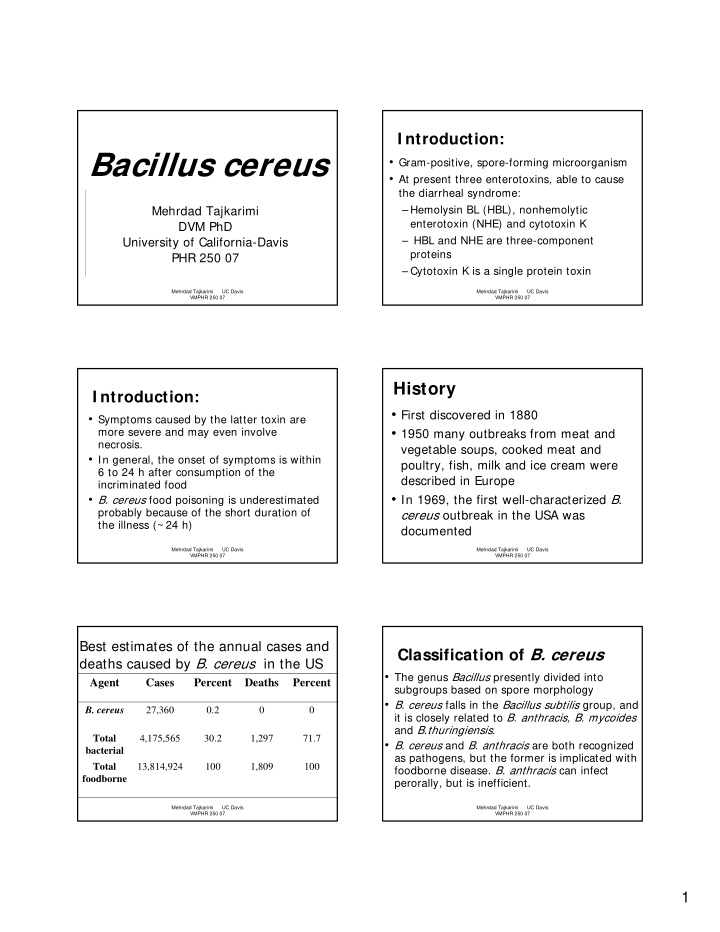



I ntroduction: Bacillus cereus • Gram-positive, spore-forming microorganism • At present three enterotoxins, able to cause the diarrheal syndrome: – Hemolysin BL (HBL), nonhemolytic Mehrdad Tajkarimi enterotoxin (NHE) and cytotoxin K DVM PhD – HBL and NHE are three-component University of California-Davis proteins PHR 250 07 – Cytotoxin K is a single protein toxin Mehrdad Tajkarimi UC Davis Mehrdad Tajkarimi UC Davis VMPHR 250 07 VMPHR 250 07 History I ntroduction: • First discovered in 1880 • Symptoms caused by the latter toxin are more severe and may even involve • 1950 many outbreaks from meat and necrosis. vegetable soups, cooked meat and • In general, the onset of symptoms is within poultry, fish, milk and ice cream were 6 to 24 h after consumption of the described in Europe incriminated food • B. cereus food poisoning is underestimated • In 1969, the first well-characterized B. probably because of the short duration of cereus outbreak in the USA was the illness (~ 24 h) documented Mehrdad Tajkarimi UC Davis Mehrdad Tajkarimi UC Davis VMPHR 250 07 VMPHR 250 07 Best estimates of the annual cases and Classification of B. cereus deaths caused by B. cereus in the US • The genus Bacillus presently divided into Agent Cases Percent Deaths Percent subgroups based on spore morphology • B. cereus falls in the Bacillus subtilis group, and B. cereus 27,360 0.2 0 0 it is closely related to B. anthracis, B. mycoides and B.thuringiensis . Total 4,175,565 30.2 1,297 71.7 • B. cereus and B. anthracis are both recognized bacterial as pathogens, but the former is implicated with Total 13,814,924 100 1,809 100 foodborne disease. B. anthracis can infect foodborne perorally, but is inefficient. Mehrdad Tajkarimi UC Davis Mehrdad Tajkarimi UC Davis VMPHR 250 07 VMPHR 250 07 1
Criteria to differentiate among four Factors Affecting Growth of B. closely related Bacillus spp. cereus Species Colony Motile Hemolysis Susceptibility Parasporal Virulent • Growth temperature 7-49 ° C with a to Penicillin to Mice Body minimum of 4-5 ° C , maximum 48- B. cereus White Yes Yes No No No 50 ° C B. anthracis White No No Yes No Yes • Generally, spore germination B. mycoides Rhizoid No No No No No temperature range from 8-30 ° C B. White/ Yes Yes No Yes No • pH 4.9-9.3 thuringiensis Grey Mehrdad Tajkarimi UC Davis Mehrdad Tajkarimi UC Davis VMPHR 250 07 VMPHR 250 07 Factors Affecting Growth of B. Name of I llness Caused by B. cereus cereus • Water activity 0.91-0.93 • B. cereus has two recognized types of foodborne illness: diarrheal , emetic • Salt as high as 7.5% NaCl, some tolerate • The emetic syndrome is caused by cereulide, 10% • D value for spores at 100 ° C around 3 min a heat- and pH stable peptide toxin • Consumption of food contaminated with this • The dose for 90% reduction of spores is toxin may lead to emesis between 30 min 1.25 - 4kGy and 5 h after ingestion • 0.17-0.65 kGy for vegetative cells Mehrdad Tajkarimi UC Davis Mehrdad Tajkarimi UC Davis VMPHR 250 07 VMPHR 250 07 Name of I llness Caused by B. Comparison of diarrheal and emetic cereus types of B. cereus food poisoning • The diarrhoeal syndrome is caused by enterotoxins Syndrome I ncubation Duration Dose Foods that are produced during growth of B. cereus in the small intestine 10 3 -10 7 CFU, Diarrheal 8-16 h 12-24 h Milk, soup, meat • The diarrheal illness (more common in North America ingested products, puddings and Europe) is caused by a high molecular weight protein • 10 5 -0 8 per g of In some outbreaks there seems to be an overlap Emetic 1-5 h 12-24 h Rice, pasta, between the diarrheal and the emetic types of illness food noodles, pastries Granum, P.E. (1994). Mehrdad Tajkarimi UC Davis Mehrdad Tajkarimi UC Davis VMPHR 250 07 VMPHR 250 07 2
Which Food? Which Food? • Other foods such as sauces, • Milk, vegetables, meat, and fish pastries, soups, puddings, and • The emetic type of poisoning salads were identified as include rice products, potato, pasta, and cheese products vehicles in food poisoning outbreaks Mehrdad Tajkarimi UC Davis Mehrdad Tajkarimi UC Davis VMPHR 250 07 VMPHR 250 07 Comparison of food poisoning caused by different bacterial I nfective Dose agents � . Pathogen Incubation Duration of Dominating Type of Frequently • Infective dose of B. cereus (h) Illness, h Signs Disease Implicated Food ranges from 10 4 to 10 11 cells B. cereus * , 8-16 12-24 Diarrhea toxico- Meat products, diarrheal infection soups, vegetables, puddings and sauces per gram of food C. perfringens 8-16 12-24 Diarrhea toxico- Meats, meat infection products, and gravy B. cereus ** , 1-5 12-24 Diarrhea Intoxication Fried rice from emetic (fairly Chinese restaurants common) and � take out � shops vomiting S. aureus 1-5 12-24 Diarrhea Intoxication Cooked meats and Vomiting poultry and dairy products Gilbert, R.J. and Kramer, J.M. (1987). Mehrdad Tajkarimi UC Davis Mehrdad Tajkarimi UC Davis VMPHR 250 07 VMPHR 250 07 Detection of B. cereus Prevention: • Blood agar can be used as a plating • Preventing contamination of food with medium its spores is almost impossible • Nutrient broth followed by blood agar • Inhibit spore germination and prevent useful for most probable number the growth of vegetative cells in count cooked, ready-to-eat foods Mehrdad Tajkarimi UC Davis Mehrdad Tajkarimi UC Davis VMPHR 250 07 VMPHR 250 07 3
Prevention: • Temperatures under 100 ° C (212 ° F) Thank you ! might allow spore survival • Non-refrigerated storage of foods and especially rice should be avoided • Foods that require heating or cooling should undergo that process rapidly Mehrdad Tajkarimi UC Davis Mehrdad Tajkarimi UC Davis VMPHR 250 07 VMPHR 250 07 4
Recommend
More recommend